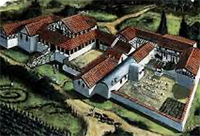Latifundia: Roman Farm Estates
From the earliest days, many people who lived in Rome and other Italian cities were farmers, tilling the land, and growing various crops, husbanding various animals, and otherwise providing for themselves. As people consolidated into cities and confederations, they combined resources. As cities grew, many people moved into non-farming areas. 
As Rome grew, conquering rivals, it gained more and more land. The state distributed this land as it saw fit, although a law passed in 367 B.C. limited any one individual to ownership of 500 iugera (or 325 acres). The more land that was available, the more people wanted. The more land that people wanted, the more the state overlooked or otherwise ignored such restrictions on land ownership. Tiberius Gracchus reintroduced the 500 iugera limit in 133 B.C., and this was met with considerable opposition that ultimately ended in his death. Ultimately arising out of this land growth was the latifundium ("spacious estate"). These latifundia were very large in some cases, filled with rich farmland on which the owner grew any number of things. Colonial latifundia grew grain for export back to Rome. Other imports included olive oil and wine. Still others husbanded livestock on a large scale. Working on these large estates were, for the most part, slaves (although tenant farmers did make up a certain part of the workforce in the later days of the Empire). The owner lived in a large villa on the estate.  Owners of latifundia enjoyed the fruits of others' labors, pocketing large profits in some cases, enabling them to buy up even more land and increase their holdings. Such large land ownership and wealth were early on a requirement for membership in the Senate. As with other elements of the well-to-do, the more land and money he had, the more power he could wield and more land and money he could further obtain. As Rome advanced through the days of the Empire, the majority of farmland was in the hands of these wealthy landowners, who had all but put early Rome's small-landholding farmers out of business. The many became the few. |
|




